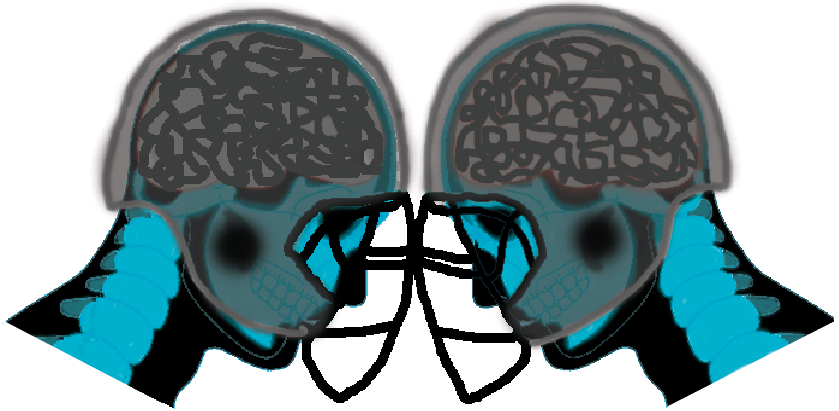The brain’s kryptonite
Hard hits in football are commonplace, but players at all ages are beginning to realize the costs associated with the game’s violence.
A concussion’s true effect can be much more severe than the seemingly short-term injury. Signs of a concussion’s harmful effects are found in the youth, high school, college football and professional players in America.
Last fall, I suffered a concussion in a soccer game from slamming my head into the ground off a head ball. Because of the few head balls during games, concussions in soccer are mainly, like football, collision-based.
One reason for the decline in youth football participation is because of the concussion lawsuits involving the NFL and it’s former players. Dave Duerson (2011), Jovan Belcher and Junior Seau (each 2012), committed suicide due to after effects from concussions sustained while playing.
All three players played in high contact positions: Duerson (safety), Belcher and Seau (linebackers). Following brain examinations, each player was later diagnosed with CTE (Chronic Traumatic Encephalopathy: a degenerative brain disease). The consistent head collisions are significant because athletes who have been concussed are three times more likely to suffer another concussion in the same season, according to LM Gissell of US National Library of Medicine National Institutes of Health. A concussion is essentially a brain bruise; it needs time to heal.
I had a more severe concussion than a standard one meaning a two- week recovery, as I dealt with constant headaches for months after the fall 2014 soccer season. I was concussed in early October 2014, then returned to play two and a half weeks later, but after the season ended, I didn’t feel like my normal self until March. I went through post-concussive symptoms for over five months, going to multiple doctor visits and even taking a test to determine if there was anything the doctors couldn’t detect affecting me.
During the 2015 NFL offseason, some players made the decision to retire at an early stage in their career in order to limit their future health risks. Former San Francisco 49ers linebacker Chris Borland is the most notable player to leave the NFL this offseason because he is 24 and was in his first pro season. Borland saw football as too big a risk to his long-term health, so he decided to end his career after just one season. “If there were no possibility of brain damage, I’d still be playing,” Borland said via ESPN.
From the deaths of former NFL players to current players retiring early, people are starting to understand what a concussion can truly do to someone who is uninformed about the correct protocol for treating one. Many players get concussions every week, but their toughness or sheer love for the game stands in the way of their long-term health.
Past the concussion, I am lucky that I am able to play sports without problems now, but because of the injury I have never felt the same about watching contact sports – especially football. I cringe at every hit I see now and am astonished how guys like Wes Welker, an NFL wide receiver, can continue playing after three concussions in 2014, and risk his long-term health for the short-term pain and glory.
Between brain examinations at Boston University and the Department of Veteran Affairs over the last two years, they have found CTE in brain tissue in 131 out of 165 individuals who previously played football in high school, college, semi-pro and professionally.
According to a report by ESPN in 2013, participation in Pop Warner youth football leagues dropped 9.5 percent from 2010 to 2012. And according to the Wall Street Journal, organized football for individuals aged 6 to 18 years has fallen by 5.4 percent.
Surprisingly, youth soccer participation in the U.S. has decreased by 7.1 percent between 2008 and 2012, along with the overall sports participation drop of 4 percent during that time.
Just last month, U.S. Soccer announced a settlement “In a class action lawsuit against six of the largest youth soccer groups, U.S. players who are aged 10 and under will no longer be able to head the ball,” Darren Rovell of ESPN said. “While players aged 11 through 13 will be restricted by a length of practice with headers and number of total headers allowed per player per week.”
The decision will be implemented across the country in six youth leagues, development academies and in U.S. youth national teams.
There were 1,069 concussions reported between 2005 and 2014 according to CNN, but majority of those were from collisions rather than from heading a ball. If young players are properly trained and not over worked in heading drills, cases like this are not necessary.
A concussion’s potential harm is huge and a handful affected is harmed in this manner in result. Based upon who you ask and their history with football, sports or concussions in general, everyone has a different opinion for where they stand on the issue.
For me, the statistics and tragedies speak for themselves. Football is an American classic, but in light of recent discoveries of what constant head collisions do to one’s brain, and my first-hand experience, football is not worth the risk to one’s long-term health.
Your donation will support the student journalists of Kirkwood High School. Your contribution will allow us to purchase equipment and cover our annual website hosting costs.

Grade: 12
Twitter handle: @dompal88
If you could be another Call staffer, who would you be?: Reese Anderson, he knows almost everything their is to...

Grade: 12
Twitter handle: N/A
If you could be another Call staffer, who would you be?: Brian Goyda: because, it's Brian Goyda.
Interests: Art, Cooking,...












